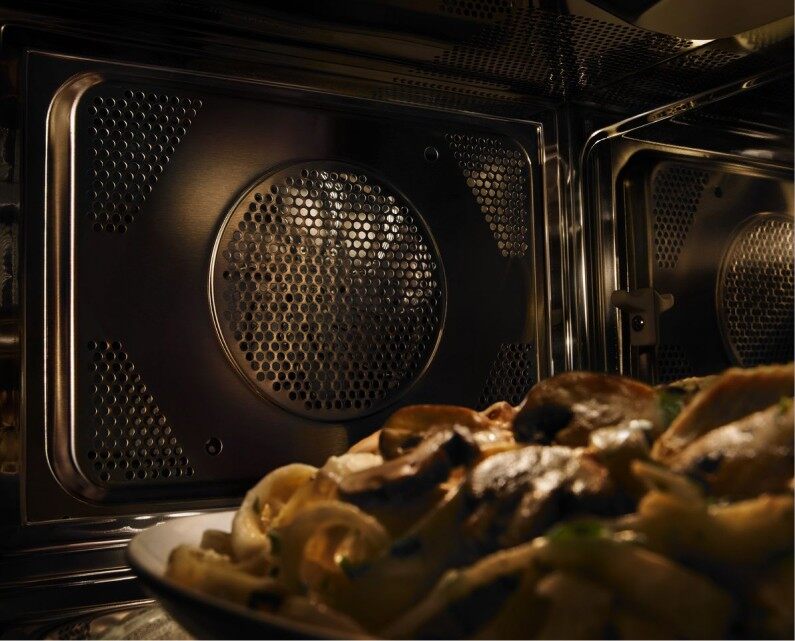If you’re remodelling your kitchen, it might be time to try a more modern appliance with more benefits than the traditional option. You’ve probably heard about convection ovens, but do you know how they work? In our conventional vs convection oven article, you will learn all about the differences and which one may be a better choice for your home.
What Is a Convection Oven?
Convection ovens have a powerful fan and exhaust system to distribute the hot air and help the food cook more evenly. Since the hot air can reach all racks better, they will have a more consistent temperature throughout. This will allow you to cook multiple meals at once and not worry about a larger meal cooking more on the top or bottom.
Convection ovens can be either electric or gas, like traditional ovens, and usually come with a bevy of features of their own.

A fan convection oven has two heating elements, one at the top and one at the bottom, and a fan in the middle to circulate the heat. Most models come with options to turn the fan on or off, allowing them to double as a regular oven – if you’re more familiar with how they work and the recipe calls for it. Therefore, a convection oven can be more versatile than a conventional oven, and all you have to do is turn the convection setting off if you ever need an oven without it.
One of the variations of a convection oven is a “true convection” oven. There is an additional heating element behind the fan in these models, allowing it to blow hot air directly around the food rather than merely distributing the heat from the other heaters. True convection ovens offer more streamlined cooking and can reduce baking times if set on the same temperature as regular thermal bake cycle counterparts.

What’s a Conventional Oven?
A conventional, also known as a traditional, regular, or radiant oven, is a model you might already be familiar with. These ovens have two heating elements, one at the top and the other at the bottom. The top element serves for broiling, while the bottom heater is used more for baking and cooking. Most people will use both heating elements to cook food more evenly.
Since the conventional oven doesn’t circulate air inside it, food will cook more the closer it is to one of the heaters. Most users are more familiar with this cooking style and have developed recipes to compensate. Additionally, some recipes specifically mention instructions for regular ovens, including rack placement and which heater to turn on and when. If you’ve used a regular oven for a while, it might take a bit of time to adjust to a convection oven’s typical faster cooking times and lower temperature requirements.
What Are the Benefits of a Convection Oven vs. a Conventional Oven?
Here are the main benefits of having a convection oven in the house:
- More even baking and heat distribution than regular ovens
- Less rotation of food inside the oven to get it to bake
- The circulated air draws out moisture, allowing for better crisping and roasting
- Convection ovens generally have faster baking and roasting times
- They preheat quickly
- The air circulation and exhausts allow you to cook multiple dishes at once on different racks
- If you turn the convection mode off, you can use the oven just like you would use a radiant one
- Modern convection ovens are energy-efficient
- Shorter cooking times means you save on energy bills
There are a few downsides to using a convection oven, namely:
- Most recipes you find online are written with the traditional oven models in mind and usually include instructions on which rack to use and the temperature requirements and cooking times for those ovens
- People are more familiar with the regular oven models
When to Use the Convection Setting
Most convection ovens allow you to turn off the convection setting when you don’t need it. However, the convection setting will have more overall benefits of even heat distribution on the food cooking quality and baking times.
The convection setting is great when roasting meats like chicken or turkey. The circulating air allows the skin to get crispy while the meat remains juicy and delicious inside.

When you’re using convection baking, some cookies and brownies will have different baking times compared to traditional ovens. You can bake cookies on multiple racks at once since there is a more even temperature spread around the oven, minimizing the chances of them getting burnt.
Food items like cakes, bread, custards, and some delicate desserts will bake better if you switch the convection setting off.
How to Use a Convection Oven
Cooking with a new convection oven might sound like a chore if you’re used to traditional ovens. However, there are only a few basic steps you need to take to get the same or better results with convection cooking. Here’s what you need to do:
1. Convert Recipe as Needed
Some recipes are specifically written with a radiant oven in mind. These recipes often need some adjustment. Modern recipes will usually have additional recommended times and temperatures for convection ovens. Some ovens have a conversion mode that lets you input cooking specifications for traditional ovens and lets the appliance itself do the math for you.
2. Adjust the Temperature
If you’re not used to a convection oven, the simplest way to adjust generally is to deduct 25°F (15°C). For example, when the traditional recipe calls for heating the oven to 375°F (190 °C), try turning that down to 350°F (175°C).
3. Adjust Cooking Time
Most convection ovens will bake faster than a conventional oven. True convection ovens will cook food even faster due to the third heating element. For these ovens, generally adjust to cook for 75% of the recommended time. Remember to always check and follow your appliance use and care instructions, as it should be your primary source of information.
4. Preheat Oven
Convection ovens will usually preheat faster than conventional ovens due to a more efficient air circulation process.
5. Start Cooking
You’re ready to go! After you put in the time and temperature, just let the convection do its job and check back when it’s done.
Tips for Cooking With a Convection Oven
If you want to step up your baking game, here are some tips on convection settings:
- You may not need to rotate food while it’s in the oven. Since the fan blows air around it, there will be almost no cold spots in the oven.
- You can use a wet towel to clean the oven easily.
- You can use high-quality glass cookware in the oven.
- The convection setting tends to dry out food more, so don’t use it if you’re baking moist, delicate foods.

Do’s and Don’ts of Using a Convection Oven
Finally, here are some tips on what to do (and what not to do) when you use convection.
Do:
- Adjust recipe times and temperatures compared to traditional models.
- Use cookware with lower sides to allow air to circulate around the food more.
- Use the convection setting for browning, crisping, or roasting.
Don't:
- Don’t block the convection fan.
- Don’t put too much food in the oven.
- Don’t use convection for moist, delicate desserts such as angel cake, cheesecake, or flan.
Find Your New Oven
Are you ready to ditch the old, conventional oven ranges in favour of new models with improved cooking times and energy efficiency? For help finding an oven that matches your needs, check out our Appliance Finder Tool.





